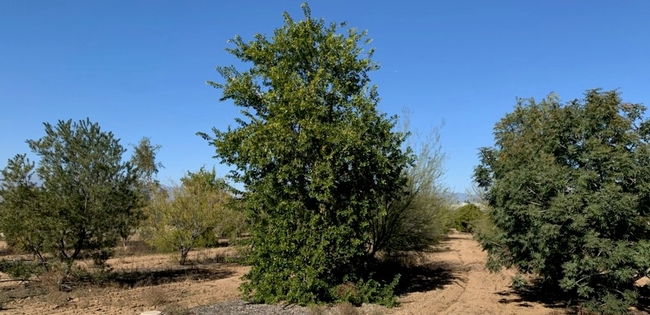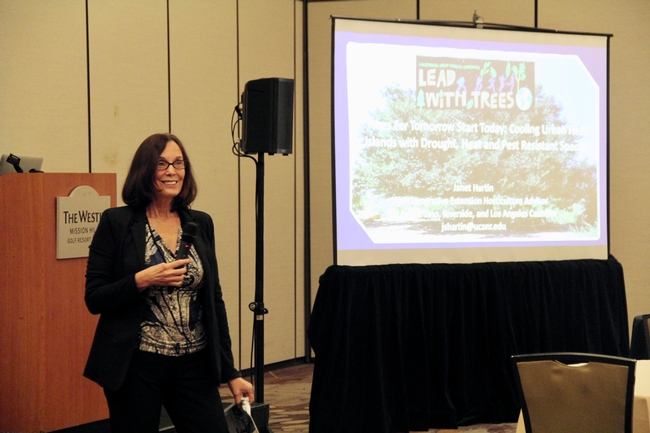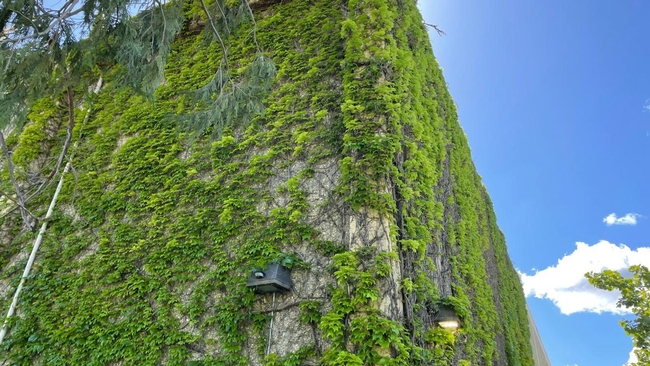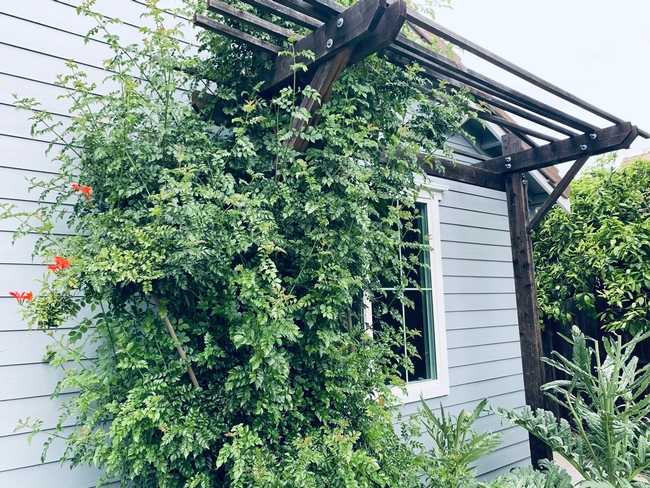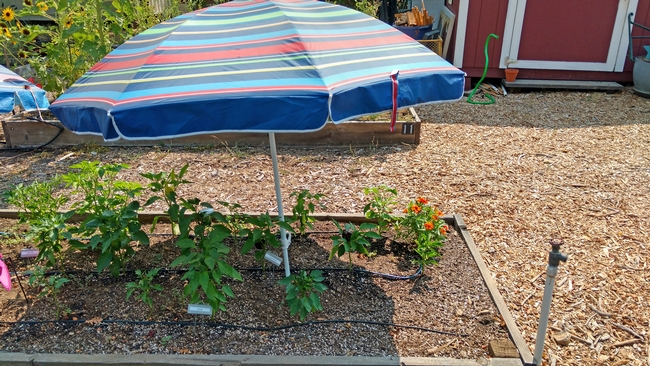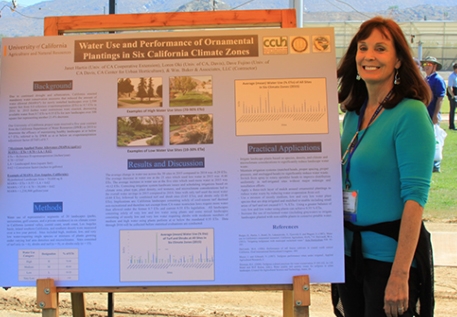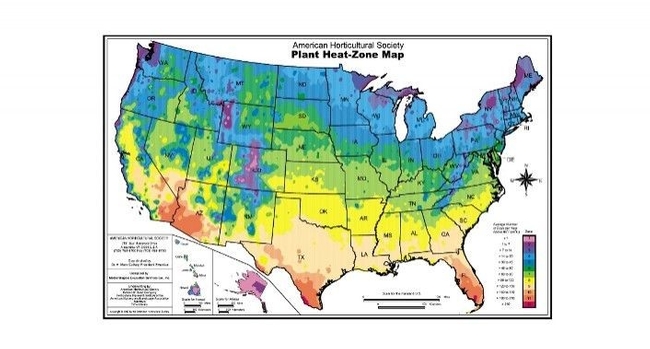Posts Tagged: heat
Now is the time to plant climate-ready trees, says UCCE researcher
In a drought-prone region like Southern California, working with Mother Nature is not only wise but necessary, according to Janet Hartin, UC Cooperative Extension horticulture advisor for Los Angeles, San Bernardino and Riverside counties, who studies climate-ready trees.
In 2020, Governor Newsom launched the California Climate Action Corps, empowering Californians to protect their communities from the impacts of climate change. Newsom's call to action emphasizes the need for long-term and sustainable solutions like Hartin's research, which urges Southern California to care for existing trees and plant new ones.
In collaboration with the U.S. Forest Service and other UC Cooperative Extension scientists, Hartin is amid a 20-year research study identifying trees suitable for California's different climate zones. Her work provides a comprehensive understanding of trees and their benefits related to human and environmental health, particularly as Californians navigate climate change's evolving challenges.
One of these concerns is urban heat islands. UHIs are areas in which heat is reradiated from paved concrete or asphalt surfaces. In cities covered in asphalt, like Los Angeles, average temperatures can become six degrees hotter than surrounding areas.
To reduce urban heat islands, she has been working with community organizations to plant trees. In March, for example, Hartin teamed up with the Inland Empire Resource Conservation District to increase tree canopy in the Inland Empire.
“We've collaborated extensively with her over the years, and we knew Janet had been developing a regionally scaled concept for connecting community members to climate-appropriate trees, alongside access to technical assistance from regional UCCE Master Gardeners to ensure long-term tree health and survival,” said IERCD District Manager Mandy Parkes.
Trees keep cities cool
To keep the city cool, some Los Angeles neighborhoods are repainting pavements with reflective coating. According to a 2020 study published in Environmental Research Letters, reflective coating can decrease pavement temperatures up to 10 degrees. As helpful as this is, augmenting urban landscapes to include heat-, drought- and pest-resistant tree species, whether native or not, can significantly reduce the impacts of urban heat islands too.
“Trees can cool impervious surfaces by 40 to 65 degrees,” Hartin said. During a 2021 study, in May and June Hartin discovered that unshaded asphalt could be more than 60 degrees hotter than shaded asphalt during late spring and early summer in inland and desert cities.
Other than providing shade, trees are effective at deflecting the sun's radiation and cooling the atmosphere through evapotranspiration. Given that they absorb and store carbon as well, trees lessen the impacts of pollution from fossil fuels.
“A well-tended mature landscape tree can absorb 40 tons of carbon over its lifespan,” said Hartin.
In a 2021 blog post, Hartin suggests trees be selected based on their adaptation to the “micro-climate” in each particular landscape, noting factors to consider like shade, proximity to buildings, space needs below and above ground, soil type and water source. She also recommends the Sunset Western Climate Zone maps for reference, noting that they are “more precise than USDA zones for our warmer climates.”
Based on the study with the U.S. Forest Service examining the performance of 12 species of underplanted but promising landscape trees at UC Riverside, favorable candidates include bubba desert willow and maverick thornless honey mesquite for their drought resistance, and red push pistache for its drought and heat resistance.
Tamara Hedges, executive director of UC Riverside Palm Desert Center and member of the Board of Directors for the Oswit Land Trust, agrees that trees are important in our fight against climate change:
“Through our partnerships with the UC California Naturalist and the Master Gardener Programs and many other nonprofits in the Coachella Valley, natural ecosystems are being protected and expanded and built environments cooled through the planting of appropriate tree species. These UC/USFS studies go a long way in identifying new underrepresented tree species."
General tips for planting
For California, planting in early fall through late winter provides ample time for trees to establish a strong root system before enduring the summer heat. Doing so also means that natural rainfall can fulfill water needs, as opposed to solely relying on irrigation systems.
Unlike newly planted trees, mature trees should be watered infrequently but deeply. Watering too often can reduce the level of oxygen in the rootzone and result in waterlogged soils prone to crown and root rots.
During the fall, trees only need about 15% of the water they would require in the summer. When watering, keep the tree trunk dry. Because the roots of the tree grow outward and are usually a foot deep into the ground, Hartin recommends watering the area around the trunk rather than the trunk itself. This will also help avoid water waste.
“Trees not adapted to the climate they're planted in and not receiving proper care are much more susceptible to invasive pests like shothole borers and diseases,” said Hartin. “Even the loss of one front yard tree can significantly reduce shade, increase the surrounding temperature, and diminish energy savings.”
Can vines speed urban cooling?
Study explores cooling benefits of fast-growing vines as trees take their time
Perhaps trees aren't the only green solution when it comes to cooling urban spaces and reducing energy costs. Honeysuckle, Virginia creeper, pink trumpet and other vines could be a fast-growing substitute in climate-smart cities of the future.
Researchers from UC Davis are leading a nearly $880,000 federal grant to study how vines may provide cooling and shade in Western states in less time than it takes a tree to grow tall.
“Vines can quickly shade buildings and reduce energy consumption while trees slowly grow to maturity,” said Alessandro Ossola, an assistant professor of plant sciences who is a principal investigator for the project. “We believe vines can be an effective and cheap measure to help cities accelerating climate change adaptation.”
The grant from the U.S. Department of Agriculture's Agricultural Marketing Service will fund work to plant and monitor at least 10 types of vines on trellises in five locations in different climate zones over three years. California Department of Food and Agriculture is administering the grant.
Using less water
Water conservation will be vital as populations rise, climate extremes become more prevalent and the demand for agricultural and drinking water increases. The goal of this research is to identify vines that can help save energy by providing cooling and reduce the need for irrigated water.
“In addition to rapid growth rates, vines can be easily integrated with structures to maximize potential cooling effects,” said Loren Oki, a Cooperative Extension specialist with Department of Plant Sciences, who is the project lead. “But we need to understand the relationships between low water-use plants and their ability to reduce thermal loads on buildings.”
The vines will be planted, supported by a trellis and watered regularly during the first growing season to establish deep roots and healthy shoots. Over the next two years, the vines will experience low, moderate and high water allocations.
The vines will be rated on aesthetics, foliage quality, floral quantity, pest and disease resistance, appearance and other factors. Thermal images of trellis coverage and other environmental measurements will also be taken to assess shading and cooling potential, according to grant documents.
Many vines can be grown along cables and wire nets that are actually detached from walls to avoid direct contact and still provide shade, Ossola said.
“We want to understand which vine characteristics relate to fast growth, reduced water use and increased aesthetic appeal,” he added.
Outreach and education
The findings will enable recommendations to be developed for regions, planners, the landscape industry and the public. It could lead to plants being designated as “water-wise,” “low-water use,” “energy-saving” or “cooling.”
Extensive engagement and outreach will also publicize the information.
“Climate change is a great opportunity for the horticultural industry to innovate and promote climate-ready plant productions,” Ossola said.
USDA funding supports research across state lines to find innovative solutions to regional and national problems, USDA Under Secretary for Marketing and Regulatory Programs Jenny Lester Moffitt said in a news release announcing this and other grants.
“This year's funded projects will address a range of those challenges, from energy and water saving in vine plants, finding cost-effective solutions for heat tolerance and drought, to addressing food safety risks for produce,” Moffitt said.
Scientists from the University of Arizona, University of Washington, Utah State University and the South Coast Research and Extension Center at UC Agricultural and Natural Resources are contributing to the research and will be overseeing vine sites in their states.
This article is reprinted from the UC Davis College of Agricultural and Environmental (CA&ES) website, where it is titled "Could Vines Be the Answers to Speeding Urban Cooling, Water Reduction in the West?"
Honey Bees and the Hot Spell
Earlier this week the National Weather Service warned us about an excessive heat spell--"dangerous and record-breaking heat conditions" here in...
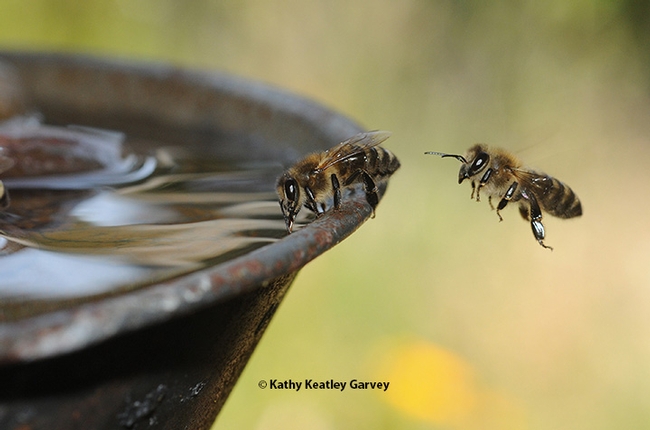
Honey bees at a water fountain at the Harry H. Laidlaw Jr. Honey Bee Research Facility, UC Davis. (Photo by Kathy Keatley Garvey)
Protect your garden when temperatures soar
When unusually hot weather is in the forecast, it's time irrigate, shade and mulch plants to protect your plants, reported Sandra Barrera in the Los Angeles Daily News.
The story was prompted by a heat spike in Southern California recently, when temperatures soared above 110 degrees in many areas.
"While most plants can endure triple-digit temperatures, they suffer when heat comes on suddenly," the article said.
- When a plant is dry, it's already stressed, so give it a good soaking before temperatures rise.
- A patio umbrella, bed sheets or landscape shade cloth suspended on the sunny side of a plant will shade tender growth on hot days.
- A three- to four-inch layer of mulch around plants will cool roots and hold moisture.
One of the best ways to avoid heat damaged trees and plants is by planning a garden for the climate.
"In Southern California, Sunset zones are preferred over USDA zones due to their greater accuracy," said Janet Hartin, UC Cooperative Extension environmental horticulture advisor for San Bernardino, Riverside and Los Angeles counties.
Hartin suggests consulting the California Native Plant Society's Calscape and Cal Poly San Luis Obispo's SelecTree for information on plants adapted to the climate and specific conditions, such as sun, shade, near buildings or swimming pools or in urban heat islands.
The American Horticultural Society also has a Heat Zone Map to select plants adaptable to inland and desert climates. The map has 12 zones searchable by city. Each zone designates the average number of days per year temperatures exceed 86 degrees, which is considered by the point at which most plants begin to suffer heat stress.
"The numbers are relatively conservative and many plant enthusiast experimenters are already finding that many plants - under the right conditions and a little shade - do just fine outside of their listed heat zone," Hartin said.
Managing alfalfa hay during heat waves
Dog gone it's hot! This is expected in our Central Valley at this time of year, but when heat waves hit, it's important to be prepared with good...


